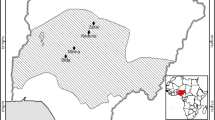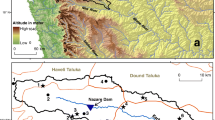Abstract
Agriculture is a critical part of Nigeria’s economy as it employs a large proportion of the population. However, climate change is a threat to agriculture in many parts of Nigeria especially the north-eastern part where the Lake Chad basin is a prominent victim. Yet, the Lake Chad basin is crucial to food security in Nigeria as most of the grains are grown there. Thus, prudent management of water resources and agricultural planning is required to ensure the sustainability of crop production in the basin. This study applied the Thornthwaite water balance model to compute the water balance of select crops in the basin to devise a better farming practice based on the findings. The study period was divided into two, the base period (1945–1979) and the second period (period of change 1980–2014). The findings show that there is a significant change or variability in climate between the two periods. However, the change is higher in Nguru which may be due to its higher latitudinal location and the desert encroachment due to poor land-use management. However, with the proposed bi-annual cropping of the select crops, it is possible to have double seasons of planting in the study area. The first season will be from May–September and the second from October–February. Since the water need of these crops is not so demanding, the crops can be grown twice with prudent water management via rainwater harvesting and minimal groundwater withdrawal. Further studies are suggested to work out the irrigation schedule for the different crops to minimise waste and losses due to over-irrigation. Hence, it is recommended that improved seed crops with very short growing cycle and/or drought-tolerant species as well as developing all-year-round planning is a panacea to human and environmental concerns in the basin.



Similar content being viewed by others
References
Adeoye NO (2017) Land use conflict between farmers and herdsmen in parts of Kano, Yobe and Borno States of Nigeria: nomads’ viewpoints, Ghana. J Geogr 9(1):127–151
Ahmad I, Tang D, Wang T, Wang M, Wagan B (2015) Precipitation trends over time using Mann–Kendall and spearman’s rho tests in the swat river basin, Pakistan. Adv Meteorol. https://doi.org/10.1155/2015/431860
Allen RG, Smith M, Perrier A, Pereira LS (1994) An update for the definition of reference evapotranspiration. ICID Bull 43(2):1–34
Allen RG, Pereira LS, Raes D, Smith M (1998) Crop evapotranspiration—guidelines for computing crop water requirements. FAO Irrigation and Drainage Paper, No. 56, FAO, Rome
Anyadike RNC (1987) A multivariate classification and regionalization of West African Climates. J Climatol 7:157–164
Audu EBI, Audu HO, Binbol NL, Gana JN (2013) Climate Change and Its Implication on Agriculture in Nigeria. Abuja J Geogr Dev 3(2):8–19
Ayoade JO (1983) Introduction to climatology for the tropics. Spectrum book Ltd, Ibadan
Bello NJ (2010) Climate change: implications for food production and security in Nigeria. In Climate change impacts and adaptation: developmental issues. A special book on climate change. Nigerian Meteorological Society, pp 3, 5
Chattopadhyay G, Chakraborthy P, Chattopadhyay S (2012) Mann–Kendall trend analysis of tropospheric ozone and its modelling using ARIMA. Theor Appl Climatol 110(3):321–328
Chaudhuri S, Dutta D (2014) Mann–Kendall trend of pollutants, temperature and humidity over an urban station of India with forecast verification using different ARIMA models. Environ Monit Assess 186(8):4719–4742
Dai A, Lamb P, Trenberth KE, Hulme M, Jones PD, Xie P (2004) The recent Sahel drought is real. Int J Climatol 24:1323–1331
Ekpoh IJ (1999) Rainfall and peasant agriculture in northern Nigeria. Glob J Pure Appl Sci 5(1):123–128
Evans AM, Perschel R (2009) A review of forestry mitigation and adaptation strategies in the Northeast US. Clim Change 96(1–2):167–183
Ezeh CU, Obeta MC, Anyadike RNC (2016) Variations in the sequences of daily rainfall across Nigeria. Arab J Geosci 9(16):681
Falloon P, Betts R (2010) Climate impacts on European agriculture and water management in the context of adaptation and mitigation—the importance of an integrated approach. Sci Total Environ 408(23):5667–5687. https://doi.org/10.1016/j.scitotenv.2009.05.002
FAO (2002) Crop water requirements and irrigation scheduling. In: Savva AP, Franken K (eds) FAO irrigation manual module 4, Rome, Italy
FAO (2017) Lake Chad Basin crisis. Response strategy (2017–2019). Retrieved 9 January 2018 from http://www.fao.org/3/a-bs126e.pdf
FAO and ICRISAT (2019) Climate-smart agriculture in the Borno State of Nigeria. CSA Country Profiles for Africa Series. International Center for Tropical Agriculture (CIAT); International Crops Research Institute for the Semi-Arid Tropics (ICRISAT); Food and Agriculture Organization of the United Nations (FAO). Rome, Italy
Fereres E, Goldhamer DA, Parsons LR (2003) Irrigation water management of horticultural crops. HortScience 38(5):1036–1042
Food and Agricultural Organization (2001) Climate variability and change: a challenge for sustainable agricultural production. Committee on Agriculture
Food and Agriculture Organization of the United Nations (FAO) (1986) Irrigation management, training manual, no 3. Via delle Terme di Caracalla, 00100 Rome, Italy
Gavrilov MB, Tošić I, Marković SB, Unkašević M, Petrović P (2016) Analysis of annual and seasonal temperature trends using the Mann–Kendall test in Vojvodina, Serbia. Időjárás 120(2):183–198
Hamed KH (2011) The distribution of Kendall’s tau for testing the significance of cross-correlation in persistent data. Hydrol Sci J 56(5):841–853
Hamon WR (1961) Estimating potential evapotranspiration. J Hydraul 87:107–120
Hansen J, Sato M, Ruedy R, Lo K, Lea DW, Medina-Elizade M (2006) Global temperature change. Proc Natl Acad Sci 103(39):14288–14293
Helsel DR, Hirsch RM (2002) Statistical methods in water resources, vol 323. US Geological Survey, Reston
Hulme M (2001) Climate perspectives on Sahelian desiccation; 1973–1998. Glob Environ Change 11:19–29
IPCC (2007) Climate change 2007 synthesis report. In: Pachauri RK, Reisinger A (eds) Contribution of working groups I, II AND III to the fourth assessment report of the intergovernmental panel on climate change. IPCC, Geneva
IPCC (2013) Climate change 2013. The physical science basis. In: Contribution of working group I to the fifth assessment report of the intergovernmental panel on climate change. Cambridge University Press, Cambridge, UK and New York, USA
Israelsen OW, Hansen VE (1962) Irrigation principles and practices. Wiley, New York
Jackson RD, Reginato RJ, Idso SB (1977) Wheat canopy temperature: a practical tool for evaluating water requirements. Water Resour Res 13(3):651–656
Karmeshu N (2012) Trend detection in annual temperature and precipitation using the Mann–Kendall test—a case study to assess climate change on select states in the northeastern United States. Master of Environmental Studies Capstone Projects 47. http://repository.upenn.edu/mes_capstones/47
Kendall MG (1975) Rank correlation methods. Charles Griffin, London
Kerr JG, Eimers MC, Yao H (2016) Estimating stream solute loads from fixed frequency sampling regimes: the importance of considering multiple solutes and seasonal fluxes in the design of long-term stream monitoring networks. Hydrol Process 30(10):1521–1535
Kim C (2009) Strategies for implementing green growth in agricultural sector. In: Proceedings in green Korea 2009 - green growth and cooperation. National Research Council for Economics, Humanities and Social Science
Knox J, Morris J, Hes T (2010) Identifying future risks to UK agricultural crop production: putting climate change in the context. Outl Agric 39(4):249–256
Knox JW, Kay MG, Weatherhead EK (2012) Water regulation, crop production and agricultural water management—understanding farmer perspectives on irrigation efficiency. Agric Water Manag 108:3–8
Kowal JM, Knabe DT (1972) An agroclimatological Atlas of the northern States of Nigeria with explanatory notes. Ahmadu Bello University, Zaria
LCBC (2007) Feasibility study of the inter-basin water transfer project from Oubangui River to Lake Chad. In: International invitation for bids for the selection of consultants and engineering firms, IIFB No. 001/LCBC/IBWTP/2007
Le Houérou HN (1996) Climate change, drought and desertification. J Arid Environ 34:133–185
Lu JB, Sun G, McNulty SG, Amataya DM (2005) A comparison of six potential evapotranspiration methods for regional use in the southeastern United States. J Am Water Resourc Assoc 41:621–633. https://doi.org/10.1111/j.1752-1688.2005.tb03759.x
McCabe GJ, Markstrom SL (2007) A monthly water-balance model driven by a graphical user interface. USGS Open-File report 2007–1088
McCabe GJ, Wolock DM (1999) Future snowpack conditions in the western United States derived from general circulation model climate simulations. J Am Water Resourc Assoc 35:1473–1484
Nagarajan C, Benjamin P, Lukas R, Florence S, Janani V, Martin W, Susanne W (2018) Climate-fragility profile: Lake Chad. Adelphi, Berlin
Nicholson S, Selato J (2000) The influence of la Nina on African rainfall. Int J Climatol 20:1761–1776
Nieuwolts S (1977) Tropical climatology: an introduction to the climates of the low latitudes. Wiley, ChiChester
Obi CO (2010) Climate change and management of degraded soils for sustainable crop of production. Trop Built Environ J 1(1):33, 36 & 37
Okonkwo C, Demoz B, Onyeukwu K (2013) Characteristics of drought indices and rainfall in Lake Chad Basin. Int J Remote Sens 34(22):7945–7961
Önöz B, Bayazit M (2012) Block bootstrap for Mann–Kendall trend test of serially dependent data. Hydrol Process 26(23):3552–3560
Penman HL (1948) Natural evaporation from open water, bare soil, and grass. Proc R Soc Lond A193:120–146
Piesse M (2017) Boko Haram: exacerbating and benefiting from food and water insecurity in the Lake Chad Basin. In: Strategic analysis paper of the international strategic analysis of Australia’s global interests. Future directions international
Pohlert T (2017) Trend: non-parametric trend tests and change-point detection, 2016. R package version 0.2.0
Ringler C, Zhu T (2015) Water resources and food security. Agron J 107(4):1533–1538
Rowell DP (2003) The impact of Mediterranean SSTs on the Sahelian rainfall season. J Clim 16(5):849–862
Sun S, Wu P, Wang Y, Zhao X, Liu J, Zhang X (2013) The impacts of climate vulnerability and agricultural inputs on the water footprint of crop production in an irrigation district of China. Sci Environ 444:498–507
Tabari H, Marofi S, Aeini A, Talaee PH, Mohammadi K (2011) Trend analysis of reference evapotranspiration in the western half of Iran. Agric For Meteorol 151(2):128–136
Tekwa IJ, Bwade EK (2011) Estimation of irrigation water requirement of maize (Zea-mays) using pan evaporation method in Maiduguri, Northeastern Nigeria. CIGR J 13(1):1–7
Von Braun J (2007) The world food situation. New driving forces and required actions. International Food Policy Research Institute, Washington
Vorosmarty CJ, Federer CA, Schloss AL (1998) Potential evaporation functions compared on US watersheds: possible implications for global-scale water balance and terrestrial ecosystem modelling. J Hydrol 207:147–169. https://doi.org/10.1016/S0022-1694(98)00109-7
Wang L, Odorico PD, Evans JP, Eldridge DJ, McCabe MF, Caylor KK, Kinng EG (2012) Dryland ecohydrology and climate change: critical issues and technical advances. Hydrol Earth Syst Sci 16:2585–2603. https://doi.org/10.5194/hess-16-2585-2012
Zilefac EA (2010) Analysis of climate variability and anthropogenic impacts on the water balance of Lake Chad drainage basin. MSc thesis, Division of Water Resources Engineering, Department of Building and Environmental Technology, Lund University
Author information
Authors and Affiliations
Corresponding author
Additional information
Publisher's Note
Springer Nature remains neutral with regard to jurisdictional claims in published maps and institutional affiliations.
Rights and permissions
About this article
Cite this article
Emeribe, C.N., Ezeh, C.U. & Butu, A.W. Climatic Water Balance Over Two Climatic Periods and Effect on Consumptive Water Need of Selected Crops in the Chad Basin, Nigeria. Agric Res 10, 131–147 (2021). https://doi.org/10.1007/s40003-020-00475-2
Received:
Accepted:
Published:
Issue Date:
DOI: https://doi.org/10.1007/s40003-020-00475-2




